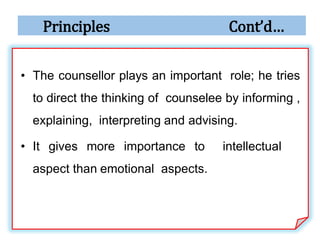Counselling involves a relationship between a counsellor and counselee where the counsellor helps the counselee organize themselves to attain happiness or adjust to life situations. It is a personal dynamic relationship where the more experienced counsellor helps the less experienced counselee find self-determined solutions. Counselling can be directive, where the counsellor guides the counselee, non-directive, where the counsellor creates an environment for the counselee to work through problems independently, or eclectic, combining elements of both approaches. The counselling process typically involves building trust, identifying issues, setting goals, interventions, and evaluation or referral.










































